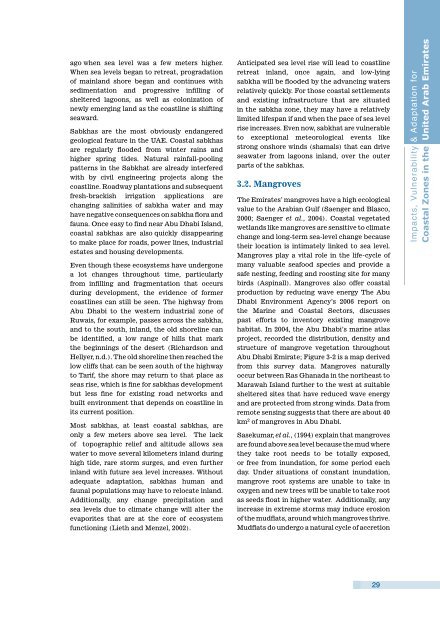climate change on UAE - Stockholm Environment Institute-US Center
climate change on UAE - Stockholm Environment Institute-US Center
climate change on UAE - Stockholm Environment Institute-US Center
You also want an ePaper? Increase the reach of your titles
YUMPU automatically turns print PDFs into web optimized ePapers that Google loves.
ago when sea level was a few meters higher.<br />
When sea levels began to retreat, progradati<strong>on</strong><br />
of mainland shore began and c<strong>on</strong>tinues with<br />
sedimentati<strong>on</strong> and progressive infilling of<br />
sheltered lago<strong>on</strong>s, as well as col<strong>on</strong>izati<strong>on</strong> of<br />
newly emerging land as the coastline is shifting<br />
seaward.<br />
Sabkhas are the most obviously endangered<br />
geological feature in the <strong>UAE</strong>. Coastal sabkhas<br />
are regularly flooded from winter rains and<br />
higher spring tides. Natural rainfall-pooling<br />
patterns in the Sabkhat are already interfered<br />
with by civil engineering projects al<strong>on</strong>g the<br />
coastline. Roadway plantati<strong>on</strong>s and subsequent<br />
fresh-brackish irrigati<strong>on</strong> applicati<strong>on</strong>s are<br />
changing salinities of sabkha water and may<br />
have negative c<strong>on</strong>sequences <strong>on</strong> sabkha flora and<br />
fauna. Once easy to find near Abu Dhabi Island,<br />
coastal sabkhas are also quickly disappearing<br />
to make place for roads, power lines, industrial<br />
estates and housing developments.<br />
Even though these ecosystems have underg<strong>on</strong>e<br />
a lot <str<strong>on</strong>g>change</str<strong>on</strong>g>s throughout time, particularly<br />
from infilling and fragmentati<strong>on</strong> that occurs<br />
during development, the evidence of former<br />
coastlines can still be seen. The highway from<br />
Abu Dhabi to the western industrial z<strong>on</strong>e of<br />
Ruwais, for example, passes across the sabkha,<br />
and to the south, inland, the old shoreline can<br />
be identified, a low range of hills that mark<br />
the beginnings of the desert (Richards<strong>on</strong> and<br />
Hellyer, n.d.). The old shoreline then reached the<br />
low cliffs that can be seen south of the highway<br />
to Tarif, the shore may return to that place as<br />
seas rise, which is fine for sabkhas development<br />
but less fine for existing road networks and<br />
built envir<strong>on</strong>ment that depends <strong>on</strong> coastline in<br />
its current positi<strong>on</strong>.<br />
Most sabkhas, at least coastal sabkhas, are<br />
<strong>on</strong>ly a few meters above sea level. The lack<br />
of topographic relief and altitude allows sea<br />
water to move several kilometers inland during<br />
high tide, rare storm surges, and even further<br />
inland with future sea level increases. Without<br />
adequate adaptati<strong>on</strong>, sabkhas human and<br />
faunal populati<strong>on</strong>s may have to relocate inland.<br />
Additi<strong>on</strong>ally, any <str<strong>on</strong>g>change</str<strong>on</strong>g> precipitati<strong>on</strong> and<br />
sea levels due to <str<strong>on</strong>g>climate</str<strong>on</strong>g> <str<strong>on</strong>g>change</str<strong>on</strong>g> will alter the<br />
evaporites that are at the core of ecosystem<br />
functi<strong>on</strong>ing (Lieth and Menzel, 2002).<br />
Anticipated sea level rise will lead to coastline<br />
retreat inland, <strong>on</strong>ce again, and low-lying<br />
sabkha will be flooded by the advancing waters<br />
relatively quickly. For those coastal settlements<br />
and existing infrastructure that are situated<br />
in the sabkha z<strong>on</strong>e, they may have a relatively<br />
limited lifespan if and when the pace of sea level<br />
rise increases. Even now, sabkhat are vulnerable<br />
to excepti<strong>on</strong>al meteorological events like<br />
str<strong>on</strong>g <strong>on</strong>shore winds (shamals) that can drive<br />
seawater from lago<strong>on</strong>s inland, over the outer<br />
parts of the sabkhas.<br />
3.2. Mangroves<br />
The Emirates’ mangroves have a high ecological<br />
value to the Arabian Gulf (Saenger and Blasco,<br />
2000; Saenger et al., 2004). Coastal vegetated<br />
wetlands like mangroves are sensitive to <str<strong>on</strong>g>climate</str<strong>on</strong>g><br />
<str<strong>on</strong>g>change</str<strong>on</strong>g> and l<strong>on</strong>g-term sea-level <str<strong>on</strong>g>change</str<strong>on</strong>g> because<br />
their locati<strong>on</strong> is intimately linked to sea level.<br />
Mangroves play a vital role in the life-cycle of<br />
many valuable seafood species and provide a<br />
safe nesting, feeding and roosting site for many<br />
birds (Aspinall). Mangroves also offer coastal<br />
producti<strong>on</strong> by reducing wave energy The Abu<br />
Dhabi Envir<strong>on</strong>ment Agency’s 2006 report <strong>on</strong><br />
the Marine and Coastal Sectors, discusses<br />
past efforts to inventory existing mangrove<br />
habitat. In 2004, the Abu Dhabi’s marine atlas<br />
project, recorded the distributi<strong>on</strong>, density and<br />
structure of mangrove vegetati<strong>on</strong> throughout<br />
Abu Dhabi Emirate; Figure 3‐2 is a map derived<br />
from this survey data. Mangroves naturally<br />
occur between Ras Ghanada in the northeast to<br />
Marawah Island further to the west at suitable<br />
sheltered sites that have reduced wave energy<br />
and are protected from str<strong>on</strong>g winds. Data from<br />
remote sensing suggests that there are about 40<br />
km 2 of mangroves in Abu Dhabi.<br />
Sasekumar, et al., (1994) explain that mangroves<br />
are found above sea level because the mud where<br />
they take root needs to be totally exposed,<br />
or free from inundati<strong>on</strong>, for some period each<br />
day. Under situati<strong>on</strong>s of c<strong>on</strong>stant inundati<strong>on</strong>,<br />
mangrove root systems are unable to take in<br />
oxygen and new trees will be unable to take root<br />
as seeds float in higher water. Additi<strong>on</strong>ally, any<br />
increase in extreme storms may induce erosi<strong>on</strong><br />
of the mudflats, around which mangroves thrive.<br />
Mudflats do undergo a natural cycle of accreti<strong>on</strong><br />
Impacts, Vulnerability & Adaptati<strong>on</strong> for<br />
Coastal Z<strong>on</strong>es in the United Arab Emirates<br />
29










